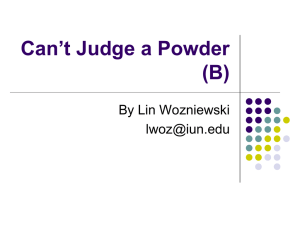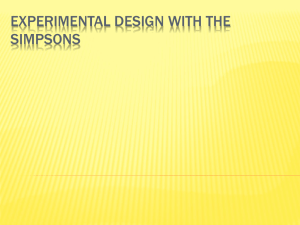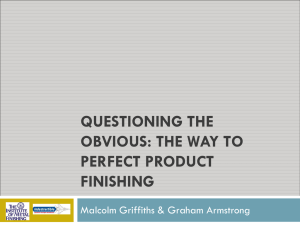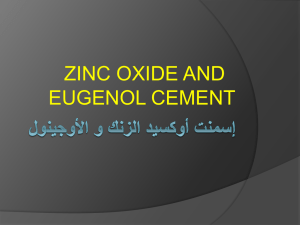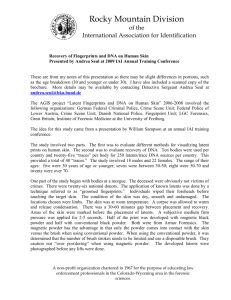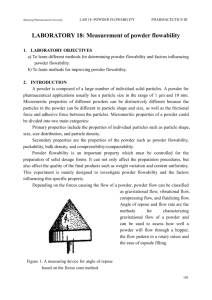Biomaterials Used in Pediatric Dentistry
advertisement
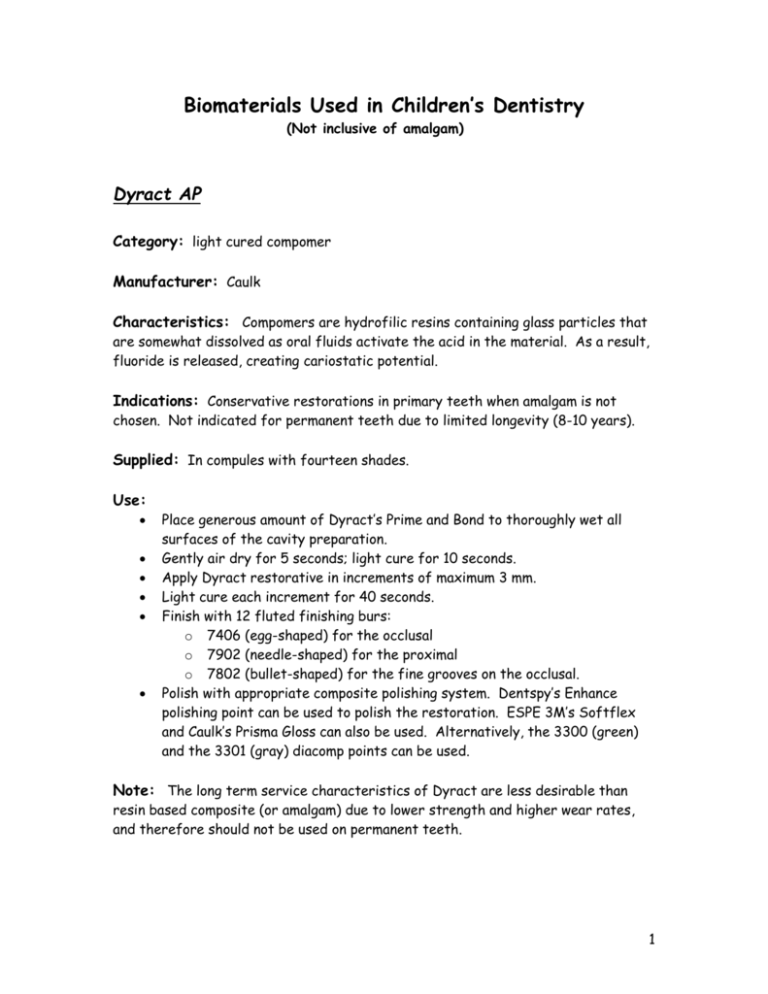
Biomaterials Used in Children’s Dentistry (Not inclusive of amalgam) Dyract AP Category: light cured compomer Manufacturer: Caulk Characteristics: Compomers are hydrofilic resins containing glass particles that are somewhat dissolved as oral fluids activate the acid in the material. As a result, fluoride is released, creating cariostatic potential. Indications: Conservative restorations in primary teeth when amalgam is not chosen. Not indicated for permanent teeth due to limited longevity (8-10 years). Supplied: In compules with fourteen shades. Use: Place generous amount of Dyract’s Prime and Bond to thoroughly wet all surfaces of the cavity preparation. Gently air dry for 5 seconds; light cure for 10 seconds. Apply Dyract restorative in increments of maximum 3 mm. Light cure each increment for 40 seconds. Finish with 12 fluted finishing burs: o 7406 (egg-shaped) for the occlusal o 7902 (needle-shaped) for the proximal o 7802 (bullet-shaped) for the fine grooves on the occlusal. Polish with appropriate composite polishing system. Dentspy’s Enhance polishing point can be used to polish the restoration. ESPE 3M’s Softflex and Caulk’s Prisma Gloss can also be used. Alternatively, the 3300 (green) and the 3301 (gray) diacomp points can be used. Note: The long term service characteristics of Dyract are less desirable than resin based composite (or amalgam) due to lower strength and higher wear rates, and therefore should not be used on permanent teeth. 1 Herculite Category: light cured resin-based composite Manufacturer: Kerr Indications: Indicated in young permanent teeth where a restorative material with greater wear resistance and longevity than a compomer (Dyract) is required. A compomer can be placed in the deepest portion of the cavity preparation to gain the cariostatic benefit, and a resin composite (Heraculite) placed over it to provide strength and wear resistance. When this is accomplished no bonding agent is needed between the two products assuming the residual uncured resin layer has not been washed from the compomer. Supplied: Unidose tip for Kerr dispensing gun. Multiple shades available. Use: Condition enamel with 37% orthophosphoric acid. Apply OptiBond Prime to enamel and dentin with a gentle scrubbing motion for 30 seconds; lightly air dry. Apply OptiBond Adhesive in a thin uniform layer and thin by air drying; light cure for 30 seconds. (Alternatively, OptiBond Solo Bond Plus can be used as a one-step procedure.) Insert Herculite into preparation with incremental thicknesses no greater than 2 mm. Light cure each increment for 40 seconds. Finish with 12 fluted finishing burs (7406, 7901, 7801) with water coolant—finishing dry damages the composite. Note: In deep lesions approaching the pulp, a cavity liner (Fuji Lining LC) should be used. Ketac-Fil Category: glass ionomer restorative material Manufacturer: ESPE 3M 2 Characteristics: Chemically bonds to both enamel and dentin by a typical acidbase reaction. Releases fluoride ions and therefore has cariostatic potential. Indication: A temporary restoration for primary teeth and permanent teeth. Supplied: In capsules for trituration; eight shades are available. Use: • Apply Ketac conditioner to the prepared dentin surface for 10 seconds. • Rinse thoroughly for 30 seconds and dry with air. • Triturate Ketac capsule for 8-15 seconds (the longer time accelerates setting). • Place in cavity preparation. • After contouring, immediately cover with Ketac Glaze, which is light cured for 10 seconds. Note: Ketac-Fil is susceptible to moisture contamination and dehydration during the setting process, therefore the need to cover and protect with the Ketac glaze. Revolution Category: flowable light-cured hybrid resin Manufacturer: Kerr Characteristics: Composite which incorporates BIS-GMA chemistry along with a glass filler (approximately 60%), yielding a flowable non-slumping restorative material. Indications: In pediatric dentistry for very conservative Class I (pit) restorations; Class III, IV and V restorations, and as a pit and fissure sealant. Supplied: Available in 16 vita shades and 5 special shades of light-cured paste. Use: • Isolate and dry the preparation; do not dessicate. • Etch enamel and/or dentin for 20 seconds with etchant; rinse thoroughly and lightly air dry. • Apply bonding agent such as OptiBond or OptiBond Solo Bond Plus. 3 • Dispense a layer of appropriate shade into preparation, cure and add incremental in layers not to exceed 2 mm. Light cure each layer for 40 seconds. • Finish and polish using conventional techniques for composite resins. • For a glaze finish, apply one or two drops of Revolution and brush over surface of restoration curing for 40 seconds. Ketac-Cem Category: glass ionomer cementing agent Manufacturer: ESPE 3M Characteristics: Chemically bonds to both enamel and dentin by a typical acidbase reaction. Releases fluoride and therefore has cariostatic potential. Indications: A cementing medium for stainless steel crowns, and bands used in space management appliances. Supplied: In capsules for trituration Use: • Dry surface of the tooth/preparation, but do dessicate. • • • • Capsule activated with plunger Triturated for 10 seconds Working time is 3 minutes Setting time is 7 minutes Note: • In deep carious lesions approximating the pulp, a cavity liner (Fuji Lining LC) should be used. • When cementing stainless steel crowns, the large capsule of Ketac Cem should be used to ensure enough material to adequately fill the inside of the crown. Durelon Category: carboxylate cement 4 Manufacturer: ESPE 3M Characteristics: carboxylate cement for fixation and lining; auto-curing powder and liquid. Indications: Cementation of stainless steel crowns and cementation of bands for space management appliances. Less commonly used today due to the existence of glass ionomer cementing agents. Supplied: Powder and Liquid Use: • For optimal adhesion, carefully clean and dry enamel, dentin, and metal • • • • • • surfaces. Do not dessicate. Do not apply carboxylate cement directly to the dentin in close proximity to the pulp or an exposed pulp; protect such with a pulpal liner. Press dosing rod into the powder, remove excess powder and place the dosed powder on a mixing pad by lightly tapping the rod. A minimum of two doses of powder is required for most uses in pediatric dentistry. Place drops of liquid adjacent to the powder on the mixing pad. Use two drops of liquid for each dose of powder; therefore four drops for the typical use. Place all powder into the liquid with one move and mix until homogenous consistency is attained; approximately 30 seconds. Cement reaches final set within ten minutes from start of mixing; shorter times at temperatures above 78 degrees.. Once set the material is very difficult to remove. To simplify cleaning, remove any excess material from all surfaces of the restoration or appliance, as well as all instruments used in mixing or placing, shortly before definitive set. Fuji Lining LC Category: light cured glass ionomer base or liner Manufacturer: GC Fuji Characteristics: chemically bonds to dentin by a typical acid-base reaction; releases fluoride and therefore has cariostatic potential. Indications: As a base or liner for deep cavity preparations 5 Supplied: Powder and Liquid Use: • Dispense powder and liquid onto mixing pad. • Ratio is one scoop of powder to one drop of liquid . • Divide powder into two equal parts. • Mix the first portion for 10-15 seconds; incorporate the second portion and continue mixing for 10-15 seconds. • Wash and dry the preparation but do not dessicate. • Line the desired area with the preparation • Light cure for 30 seconds. Clinipro Sealant Category: light-cured, fluoride-releasing pit and fissure sealant Manufacturer: ESPE 3 M Characteristics: Sealant has a unique color change feature; is pink when applied to the tooth surface, and changes to opaque light yellow color when exposed to light. Pink color prior to polymerization is designed to aid the clinician in the accuracy and amount of material placed. Indications: To seal enamel pit and fissures as a caries preventive agent. Supplied: In plastic squeeze bottles. Use: Applied to etched enamel pits and fissures with either syringe needle tip or with brush. IRM: Intermediate Restorative Material Category: resin reinforced zinc-oxide and eugenol Manufacturer: Caulk 6 Indications: As a sedative base, as a temporary restoration lasting up to one year, or can be used as the zinc oxide/eugenol/formocresol paste for a pulpotomy. USP zinc oxide and eugenol mixed with formocresol is traditionally employed for use with a pulpotomy. Supplied: Powder and Liquid Use: • Dispense powder and liquid onto mixing pad. • Ratio is one scoop of powder to one drop of liquid. • Mix one-half of the powder into the liquid initially; add the remaining powder in 2 to 3 increments. • The mix should appear stiff and not sticky; resembling Play Doh. • When used as the paste for a pulpotomy, one drop of formocresol must be added for each drop of eugenol. Note: Ideal for use in a primary tooth approaching exfoliation, which does not justify a permanent restoration. While a glass ionomer may also be used, white IRM material clearly identifies to the parent that it is a temporary and not a permanent restoration. 7


